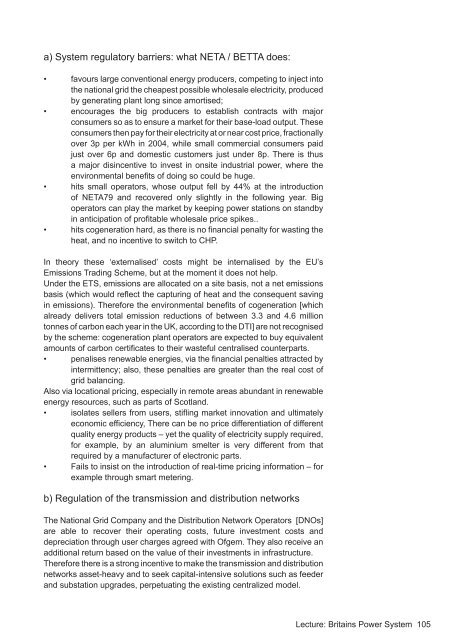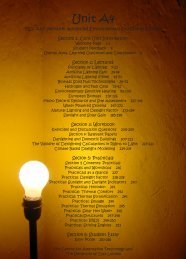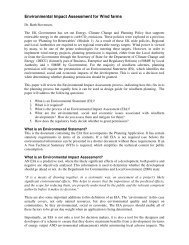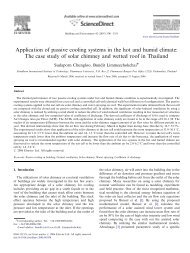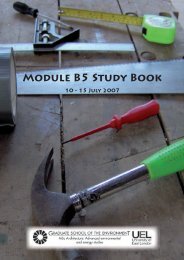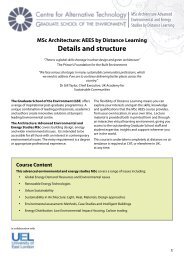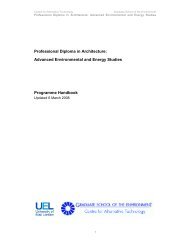Module B1 Study Book - the Graduate School of the Environment
Module B1 Study Book - the Graduate School of the Environment
Module B1 Study Book - the Graduate School of the Environment
Create successful ePaper yourself
Turn your PDF publications into a flip-book with our unique Google optimized e-Paper software.
a) System regulatory barriers: what NETA / BETTA does:<br />
• favours large conventional energy producers, competing to inject into<br />
<strong>the</strong> national grid <strong>the</strong> cheapest possible wholesale electricity, produced<br />
by generating plant long since amortised;<br />
• encourages <strong>the</strong> big producers to establish contracts with major<br />
consumers so as to ensure a market for <strong>the</strong>ir base-load output. These<br />
consumers <strong>the</strong>n pay for <strong>the</strong>ir electricity at or near cost price, fractionally<br />
over 3p per kWh in 2004, while small commercial consumers paid<br />
just over 6p and domestic customers just under 8p. There is thus<br />
a major disincentive to invest in onsite industrial power, where <strong>the</strong><br />
environmental benefits <strong>of</strong> doing so could be huge.<br />
• hits small operators, whose output fell by 44% at <strong>the</strong> introduction<br />
<strong>of</strong> NETA79 and recovered only slightly in <strong>the</strong> following year. Big<br />
operators can play <strong>the</strong> market by keeping power stations on standby<br />
in anticipation <strong>of</strong> pr<strong>of</strong>itable wholesale price spikes..<br />
• hits cogeneration hard, as <strong>the</strong>re is no financial penalty for wasting <strong>the</strong><br />
heat, and no incentive to switch to CHP.<br />
In <strong>the</strong>ory <strong>the</strong>se ‘externalised’ costs might be internalised by <strong>the</strong> EU’s<br />
Emissions Trading Scheme, but at <strong>the</strong> moment it does not help.<br />
Under <strong>the</strong> ETS, emissions are allocated on a site basis, not a net emissions<br />
basis (which would reflect <strong>the</strong> capturing <strong>of</strong> heat and <strong>the</strong> consequent saving<br />
in emissions). Therefore <strong>the</strong> environmental benefits <strong>of</strong> cogeneration [which<br />
already delivers total emission reductions <strong>of</strong> between 3.3 and 4.6 million<br />
tonnes <strong>of</strong> carbon each year in <strong>the</strong> UK, according to <strong>the</strong> DTI] are not recognised<br />
by <strong>the</strong> scheme: cogeneration plant operators are expected to buy equivalent<br />
amounts <strong>of</strong> carbon certificates to <strong>the</strong>ir wasteful centralised counterparts.<br />
• penalises renewable energies, via <strong>the</strong> financial penalties attracted by<br />
intermittency; also, <strong>the</strong>se penalties are greater than <strong>the</strong> real cost <strong>of</strong><br />
grid balancing.<br />
Also via locational pricing, especially in remote areas abundant in renewable<br />
energy resources, such as parts <strong>of</strong> Scotland.<br />
• isolates sellers from users, stifling market innovation and ultimately<br />
economic efficiency, There can be no price differentiation <strong>of</strong> different<br />
quality energy products – yet <strong>the</strong> quality <strong>of</strong> electricity supply required,<br />
for example, by an aluminium smelter is very different from that<br />
required by a manufacturer <strong>of</strong> electronic parts.<br />
• Fails to insist on <strong>the</strong> introduction <strong>of</strong> real-time pricing information – for<br />
example through smart metering.<br />
b) Regulation <strong>of</strong> <strong>the</strong> transmission and distribution networks<br />
The National Grid Company and <strong>the</strong> Distribution Network Operators [DNOs]<br />
are able to recover <strong>the</strong>ir operating costs, future investment costs and<br />
depreciation through user charges agreed with Ofgem. They also receive an<br />
additional return based on <strong>the</strong> value <strong>of</strong> <strong>the</strong>ir investments in infrastructure.<br />
Therefore <strong>the</strong>re is a strong incentive to make <strong>the</strong> transmission and distribution<br />
networks asset-heavy and to seek capital-intensive solutions such as feeder<br />
and substation upgrades, perpetuating <strong>the</strong> existing centralized model.<br />
Lecture: Britains Power System 105


